Light refracted from golden roofs on Orthodox churches and tarmac roads carved into limestone cliffs that ended in thin strips of pebble beaches: it was smooth sailing once we hit the beautiful ground of Montenegro. I should say smooth driving, as we finally got hold of a rental car last-minute during peak season. With an Airbnb in Bar and a beyond helpful host, we had everything we could wish for to both explore and relax. The beauty and tranquility of Montenegro, despite the heavy traffic, was welcome after the chaotic week we had had, which included taking the ferry to Greece, hitchhiking across the border to Albania and catching numerous buses.
Quite some of the moments in Montenegro have stayed with me these past two years. One recalls a purple sunset in the little fishing village of Perast and eating tangy cevapi in the former capital Cetinje amidst the karst formations that form her mountains. I therefore still wholeheartedly believe that this diverse country should be on everyone’s bucket list. Whether you are an outdoors adventurer, a beach rat, or a history buff: Montenegro has got it all. To convince you of its versatility and travel-appeal, I have picked my favorite and most memorable experiences, from how to get around to what to see and do, which conveniently fit into all three categories.
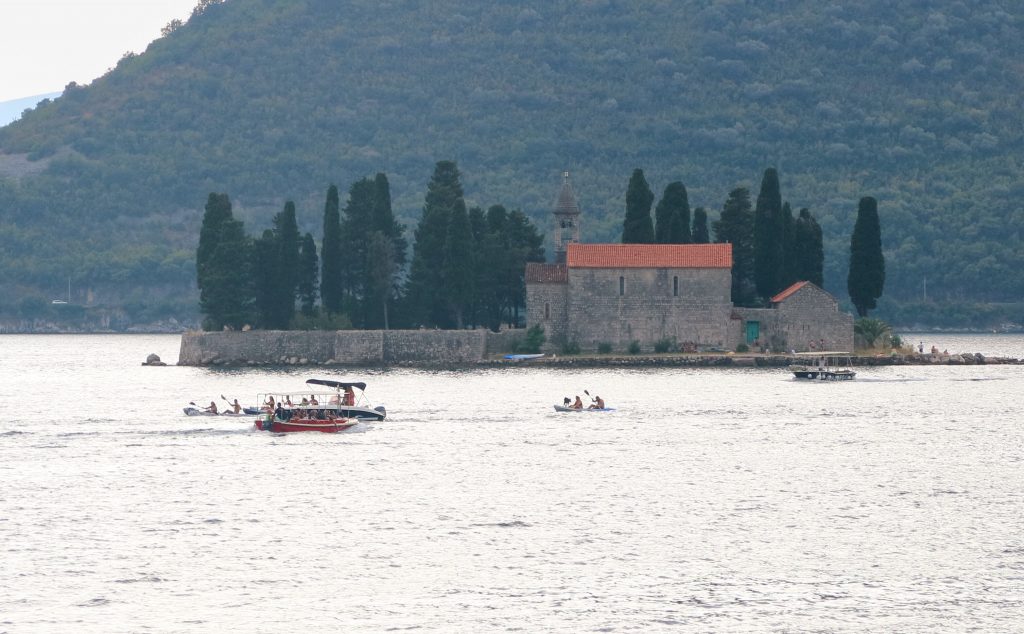
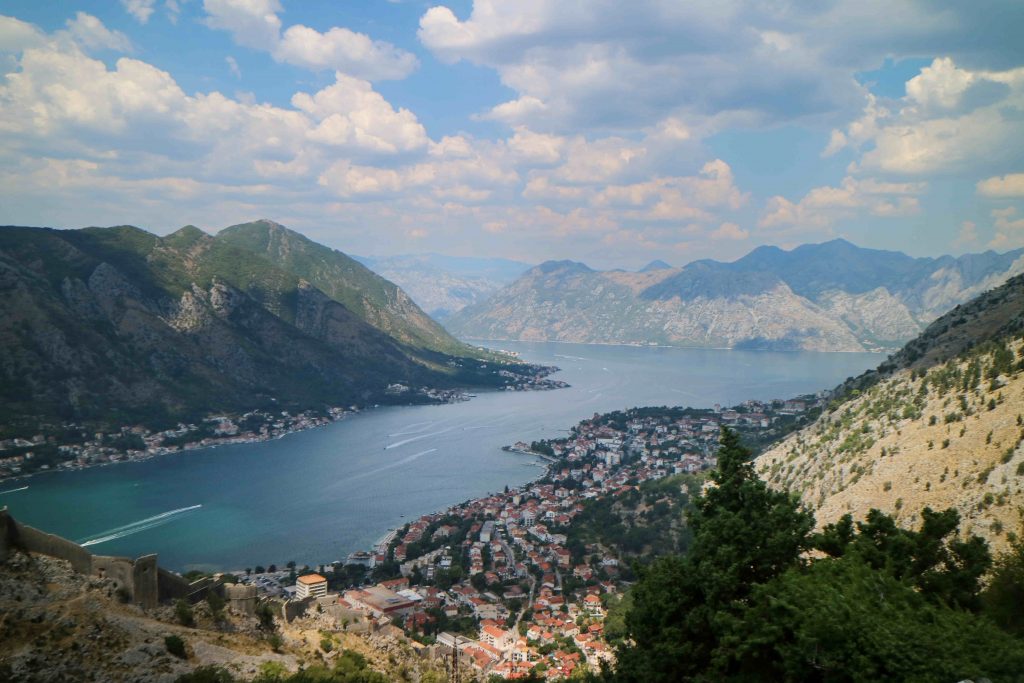
Departure from Shkodër, Albania
As we drove into Ulcinj from Shkodër, it was like we had never seen a bus station before: neat rows of buses with waiting platforms and steel gates which only opened once your bus had arrived, to stop people from crowding the platforms. This one was thrown into sharp relief thinking about our experiences in Albania, with dusty parking lots lacking any signs and no timetables anywhere. Although this led to some fun (and admittedly less fun) experiences, I had craved some structure in our cramped schedule for a couple of days.
As we drove into Bar, we were greeted by wide roads and the fanciest Orthodox Church we had seen so far. With a golden roof and stark white walls it was difficult to look at in the scorching midday sun, but like a magpie drawn to a shiny glass shard, we could not stop looking at it.
Although we could not hitch a ride this time and had to call a taxi after walking for thirty minutes into town, we finally made it. Our host Goran gave us a warm welcome, showing us around the apartment and making sure we were comfortable before he left. I had contacted him a couple of days before, after our failure to find a car in Shkodër, asking him whether he could help us rent a car for our four days in Montenegro. After we were settled into our apartment, he immediately went to his friend who rented out cars to check if the Mini Cooper he hooked us up with was still there. What a legend!
Beach Days in Bar
Not long after Goran left and we had made the clean and simple white studio apartment our home, Wessel and I put on our bathing suits walked down the hill past numerous vacation homes to the beach bar Hemingway, which conveniently was a car rental as well. We waved at Goran as we entered, who was drinking a coke at the bar and chatting with his friends.
On the beach, people were picking their way carefully across the pebbles on their bare feet, mothers were lounging on floaties as their kids snorkeled and dived, and tourists read books on sunbeds under white parasols while Montenegrin music was blasting through the stereo with their upbeat drums and adlip filled melodies. The late afternoon sun was warm on our skin as we settled onto a sunbed of our own.
Looking at fathers throwing around their kids in the water as the air filled with laughter and giggles and taking a dip in the soft water of the Mediterranean ourselves, we discussed our plans for the coming days. My best friend has her roots here and had given us some great tips on what to see: we had to go to Kotor, drive into the mountains and see Budva. Which is exactly what we decided to do.
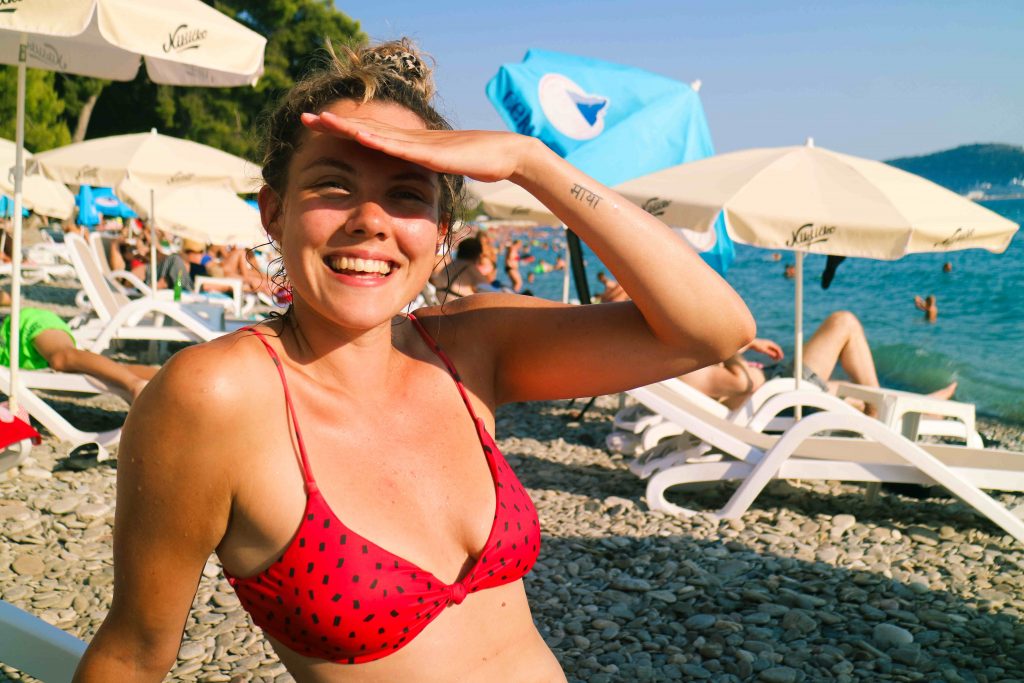
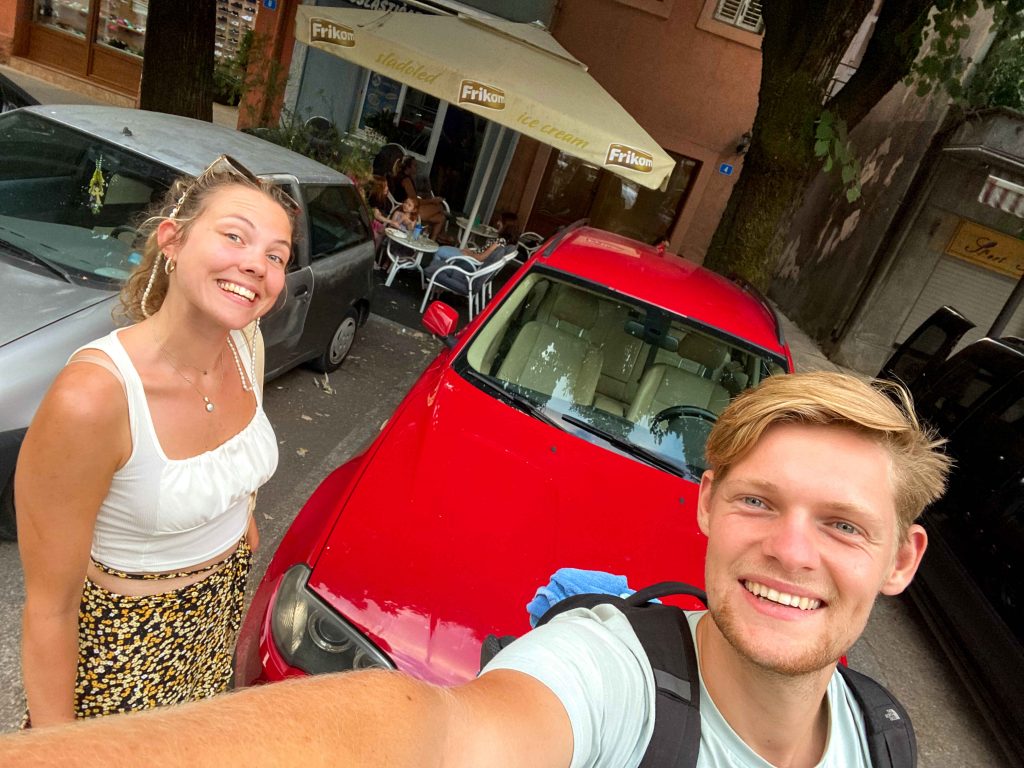
Getting Lost in the Kotor Mountains
As we left our apartment early the next morning, we could hear the cicadas chirping in the Aleppo pine and olive trees that lined the coast. Lots of families were already out and about carrying floating sunbeds and noodles (not the edible ones). As we reached Hemingway we were told the Mini Cooper was not going with us that day. Instead, we got a massive red BMW, which was a lot cooler than the Mini Cooper. It took us quite a long time to photograph all the damages on the car, which you should always do, before they charge you. But there were so many I do not think we got all of them.
The drive to Kotor took about an hour and thirty minutes and took us across the steep coasts of Montenegro specked with a great variety of bright green trees and yellow bushes. A sensation of ultimate freedom always envelops me while driving in the South of Europe. Even though we were sweating in a car lacking AC, I felt like an Italian movie star with her hair pulled back by a satin scarf, Dolce and Gabbana sunglasses perched on her nose and the roof of her red cabriolet lifted. That is what the Mediterranean coastline does with your emotions.
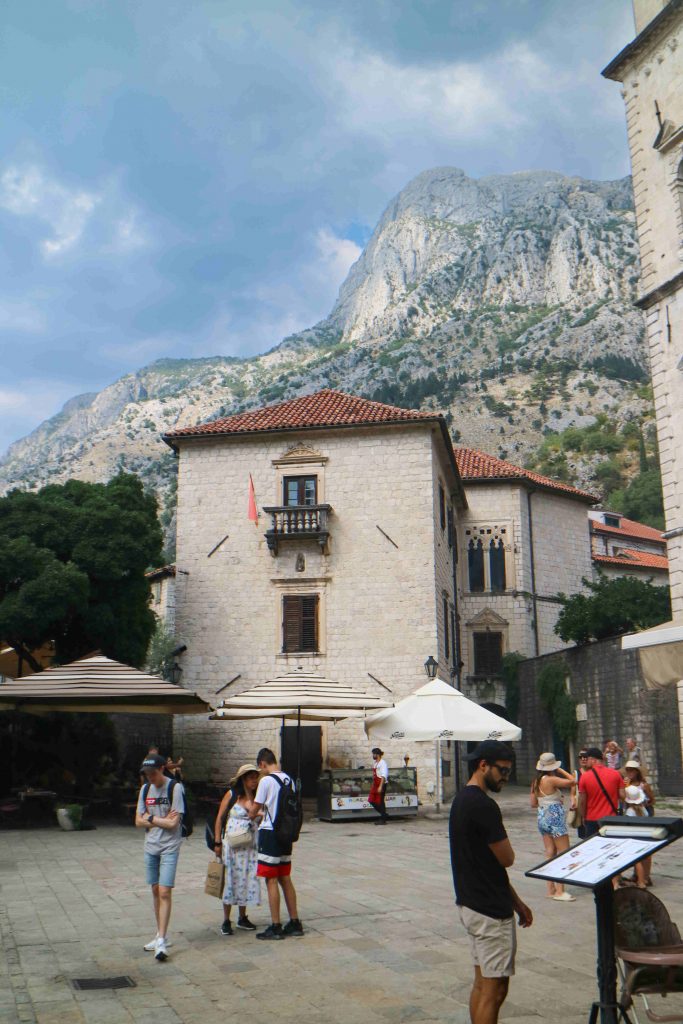
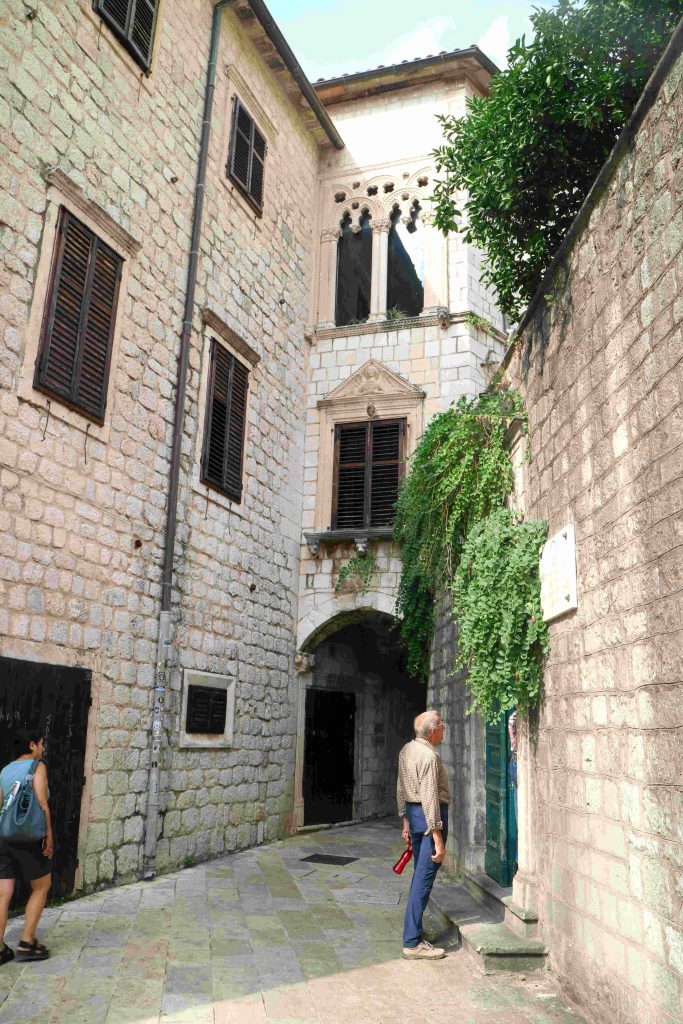
Once we entered Kotor I felt butterflies in my stomach: a medieval city with fortified walls and an extraordinary bay. From the city, you would think it is a high-altitude lake in Austria surrounded by mountains. The opening to the sea is as small as 340 meters, while the shoreline is 170 kilometers long. I could not wait to explore the city, but we had a mountain to climb.
The trail was supposed to start behind the parking lot where we parked the red BMW. We found a pathway behind some ivy-clad barbed wire fences. Slowly we made our way up a path that changed from gravel stairs to a grassy goat path. The rusty tiled roofs became smaller and smaller as we climbed up the sun-soaked mountain overlooking the Kotor Castle. As the castle itself also became smaller, we knew we had missed a turn somewhere: our plan was to visit the castle and then hike back down on the other side, into the city.

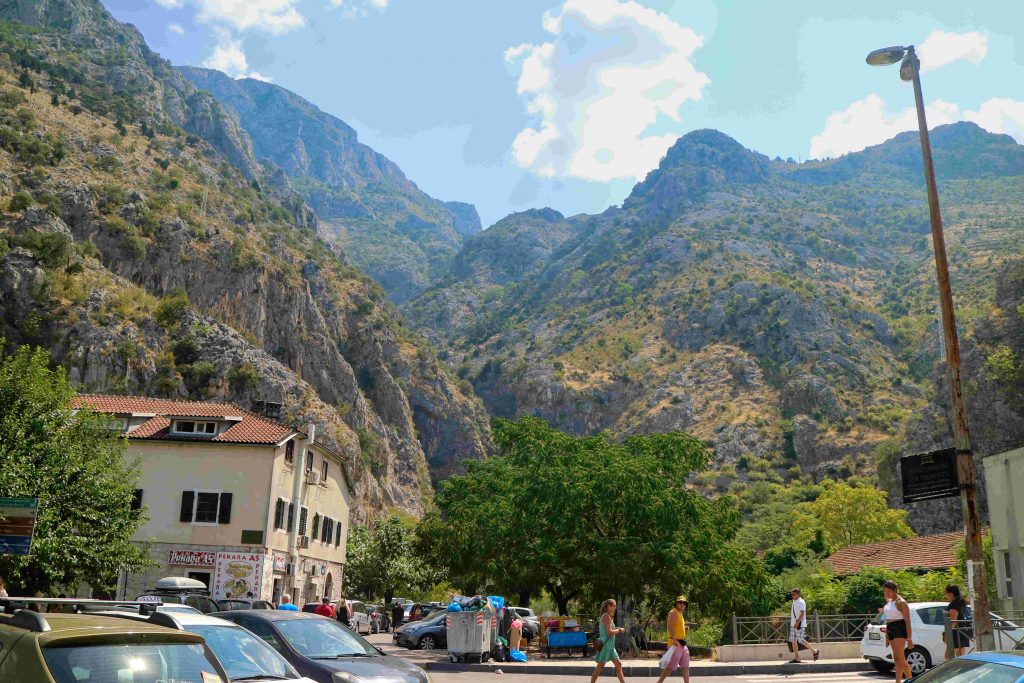
As I took the millionth picture of the view of the bay with the roofs now being small red specks, I reached for my water bottle and took the very last sip. Sheepishly I looked at Wessel: “What do we do now?” I asked him, a little nervous. “Maybe we can go back to the city again on the other side of the mountain, we’re almost there,” he replied, and shrugged.
When we reached what we thought would be the top of the mountain – but once we reached it turned out to lead up to an even higher mountain – we bumped into two Dutch hikers carrying heavy backpacks. They were absolute angels: they saw how thirsty we were and gave us some of their water, but also told us they just finished a multi-week hike. “This path will take you all the way East,” they told us, “And the next town is two hours away.” A little bummed out, thirsty, and hungry, we sat down to enjoy the view and listen to the birdsong around us. I could have sat on that grassy mountainside overlooking the bay and sea beyond for hours, but our stomachs had other plans. We decided to hike back down the way we came and find our luck in the city.
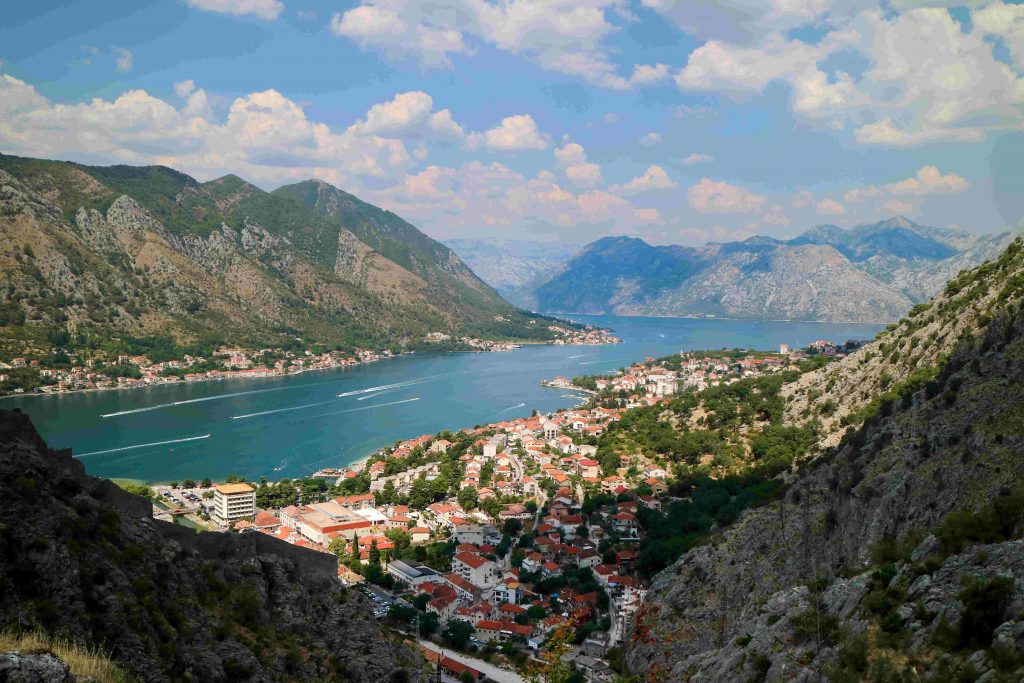
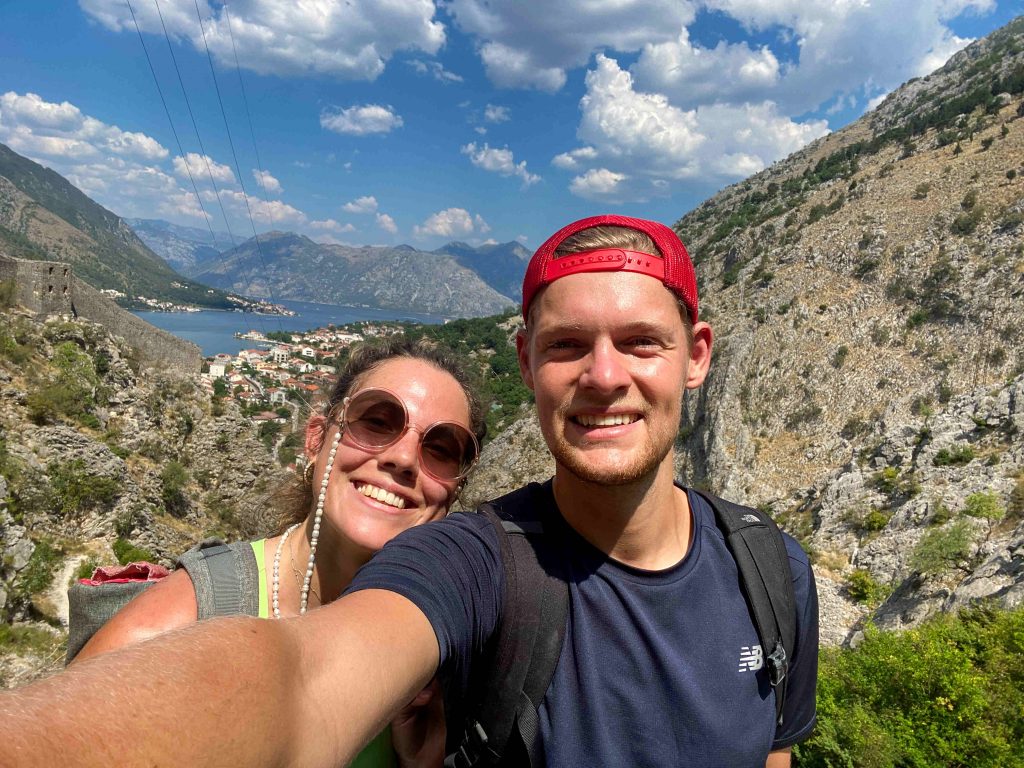
Strolling through Kotor
Overcooked and overpriced: that is what you get when you sit down at the first restaurant you see. Wessels salad looked fine, but my tuna steak tasted like its canned brother. The cappuccinos were good though, and it stilled our hunger. Unlike our food, the city itself did not disappoint in the slightest. Even bumping into hundreds of tourists from the cruises wearing baseball caps following a tour guide stick, did not sour my mood like they usually would back home.
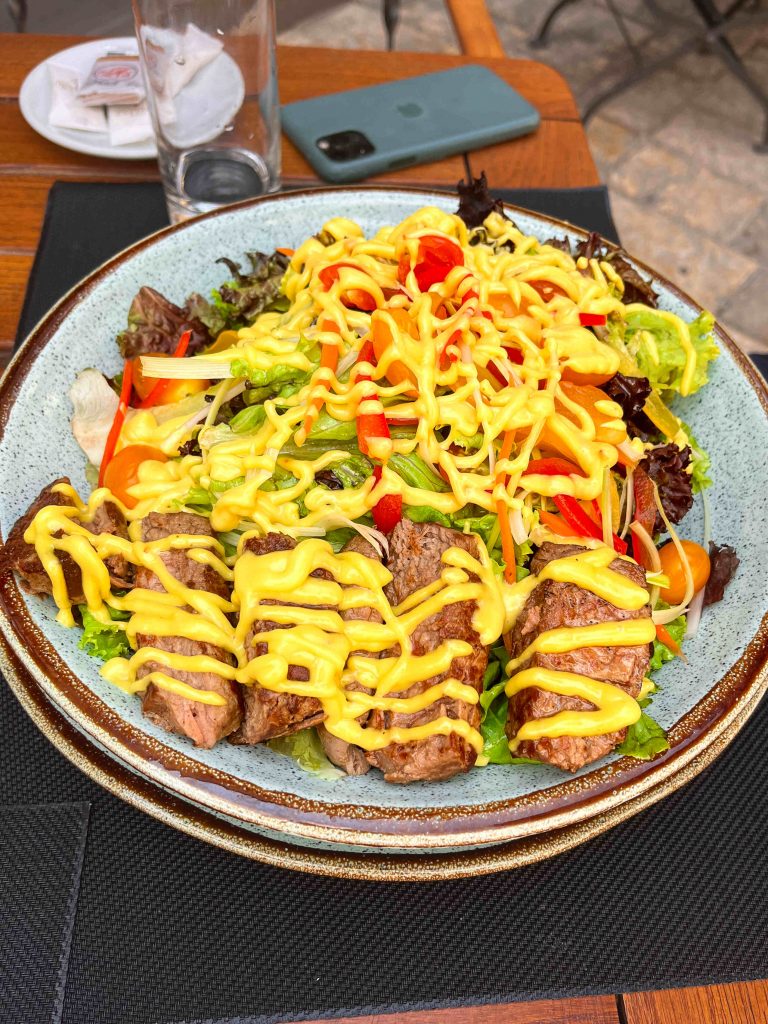
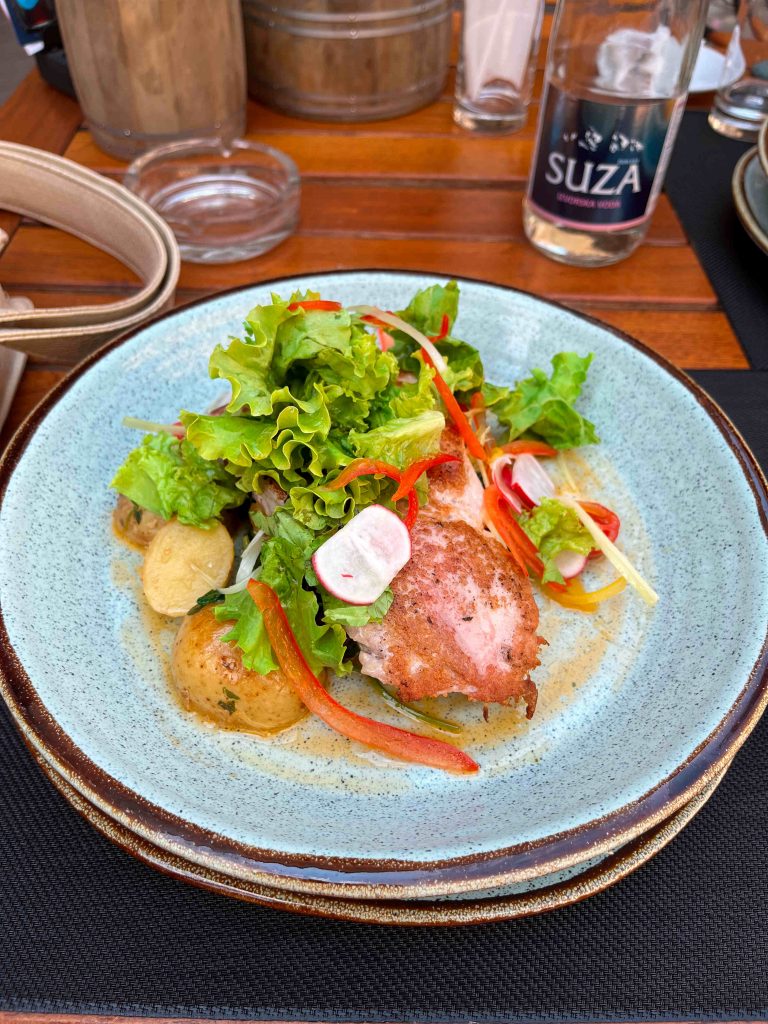
Entering the city was a treat in itself: the fortification seemed to be completely intact: the bottom a dark grey and the top a lighter stone which they probably restored a couple of years ago. Watching from the outside you could see people walking on top of the walls. The gate itself was small and thus probably easy to defend, with flags waving above it and the emblem of the city neatly carved into the stone.
Kotor could also be called a labyrinth of narrow streets, with grey and white stone buildings nearly touching each other. Squares hold byzantine churches, characterized by their two towers on either side, and a lower pointed roof in the middle, each one topped with a small iron cross. Some squares hold small markets under their vaulted ceilings displaying trinkets in glass vitrines or small stone stands. The people themselves were moving slowly, taking pictures, and looking in every direction. From the engraved buildings to the carefully tended flowers in windowsills, there is just so much to see in this small city.
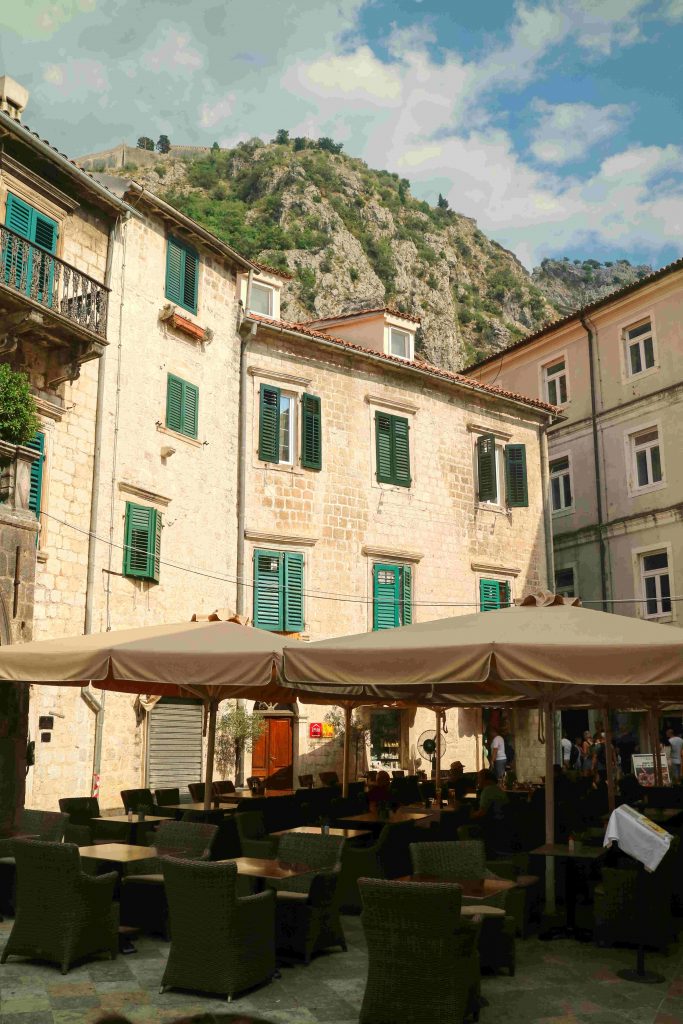
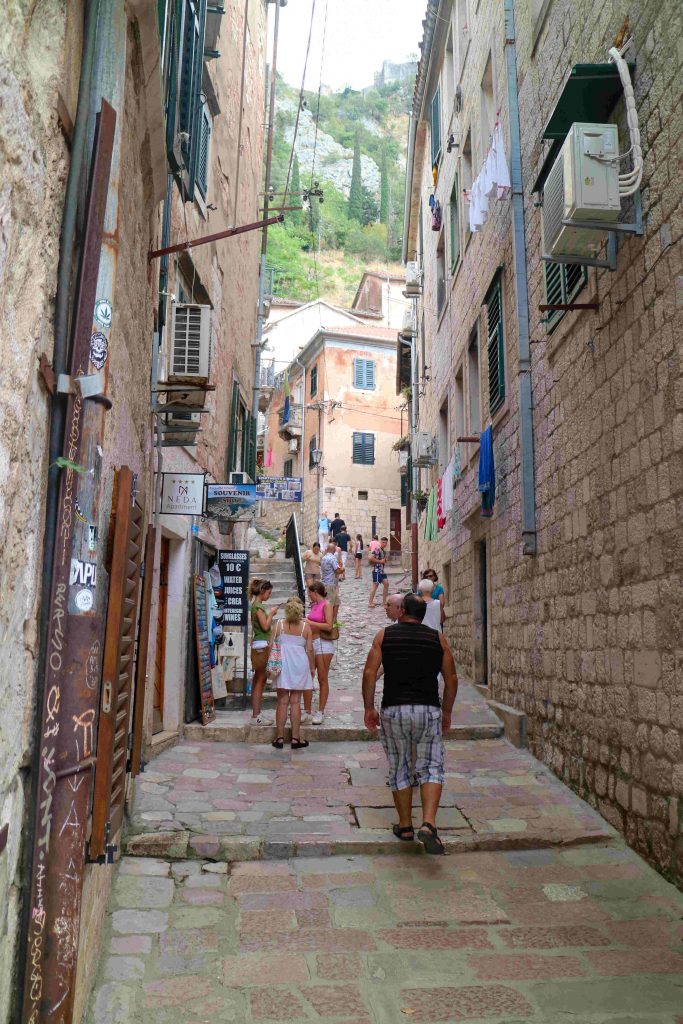
Chasing the Sunset in Perast
We had walked quite some kilometers after our hike and the two hours of sightseeing in Kotor. With dirt, dust and sweat caked onto our foreheads and shins, we felt the need to take a dip in the water of the bay. Online we had read that Herceg Novi was a great village to see when in Kotor, but that would be a very long drive as it was located on the other side of the bay. Instead, we hopped in the car and started driving along the coastline in search of a tranquil beach somewhere.
After twenty minutes or so, we heard sunny beats and people splashing in the water. Cars were lined up on the side of the street with one free spot which called our names. We walked down to the narrowest pebble stone beach we had ever seen, with the dark wooden beach club perched above it. People laid in a zig zag pattern on their towels, just so as many people could fit in the small space. The vibe was good though, and as two people at the end of the beach left, we quickly took the vacant spot, awkwardly changed into our bathing suits in a pink painted changing shack.
The sky colored pink, purple and lilac, painting the mountains blue. As the sun set behind the mountains of the bay, the water became glazy like honey. The man doing a butterfly stroke only left a few ripples in the water, and the small fishing boats tied up to red buoys rocked gently on the waves. We quickly took a dip and swam to the sound of cicadas humming in the pines and cypress trees. The bay was just as steep underwater as it was above the surface: two meters in we could no longer stand on the ocean floor.
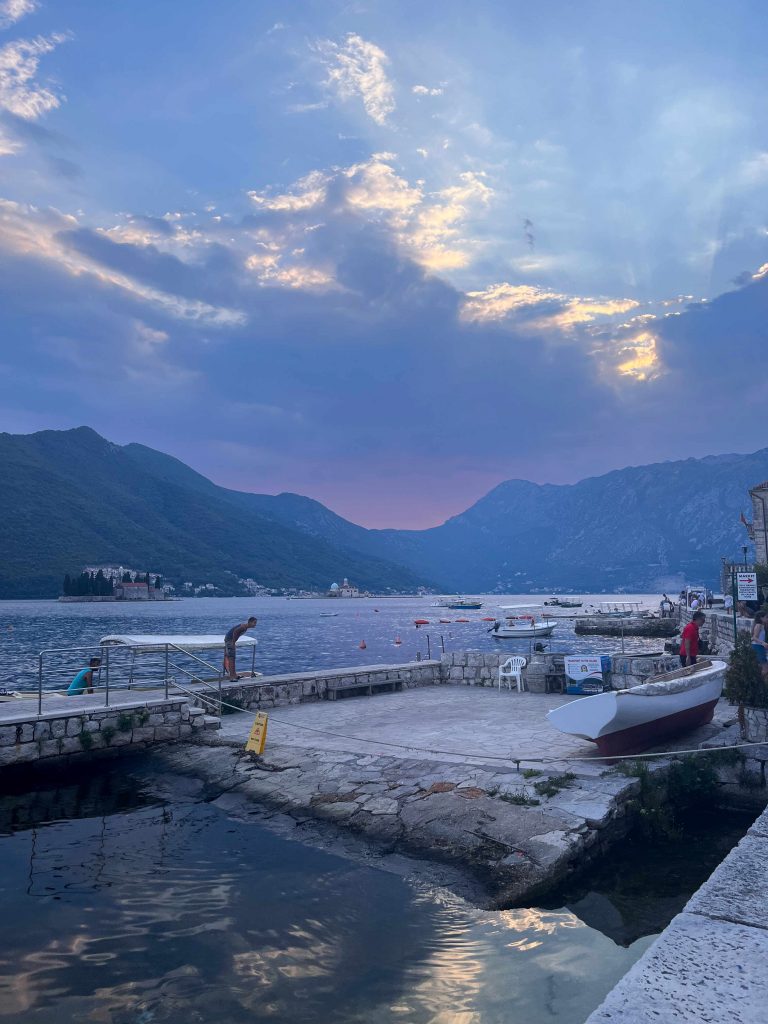
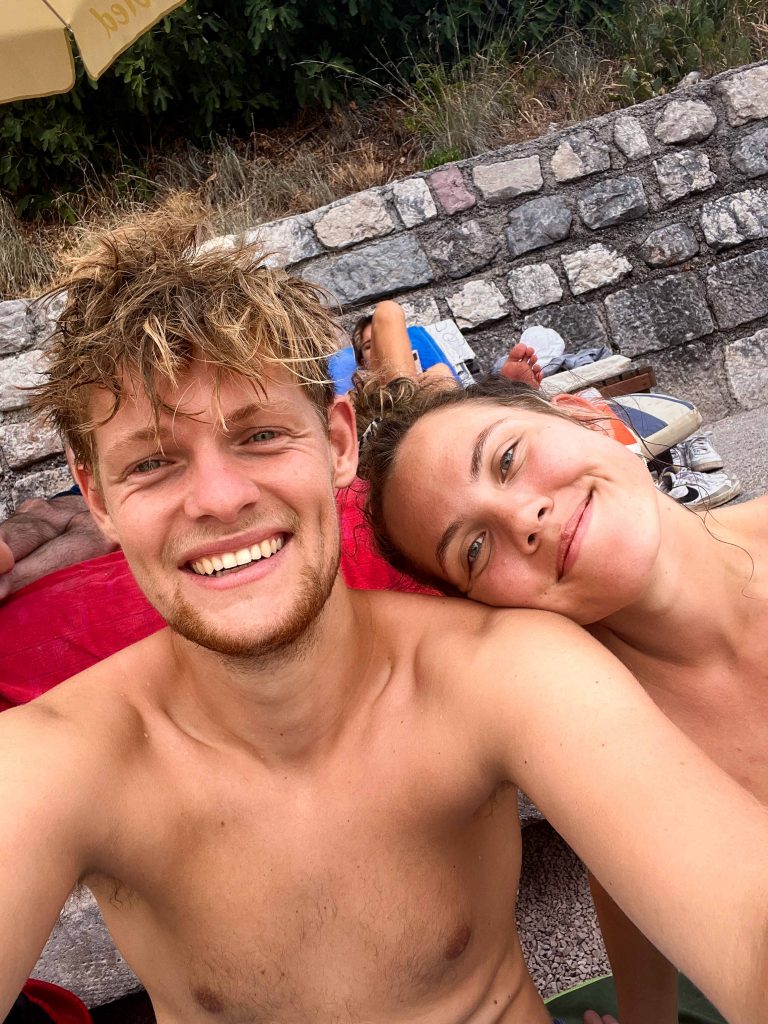
After some swimming, relaxing and peach iceteas, our stomachs started to rumble again. We knew it would take too long for us to get back to our Airbnb on the other side of the country, so we took out our Google Maps and drove to the closest village that lay on our way back.
Perast appeared before us with its burned red roofs, little church tower and coastline boulevard. Terraces with green and white parasols lined the edge of the water, which were mirrored by small boats with canvas roofs. The village seemed to be host to a couple of fancy resorts, but also some great waterfront restaurants to have some wine, cheese, olives, and charcuterie. Even though the heavy traffic on our way back still lay ahead of us, watching the sunset and red cats sneaking across the boats looking for prey while enjoying a glass of chardonnay was the perfect ending to a perfect day.
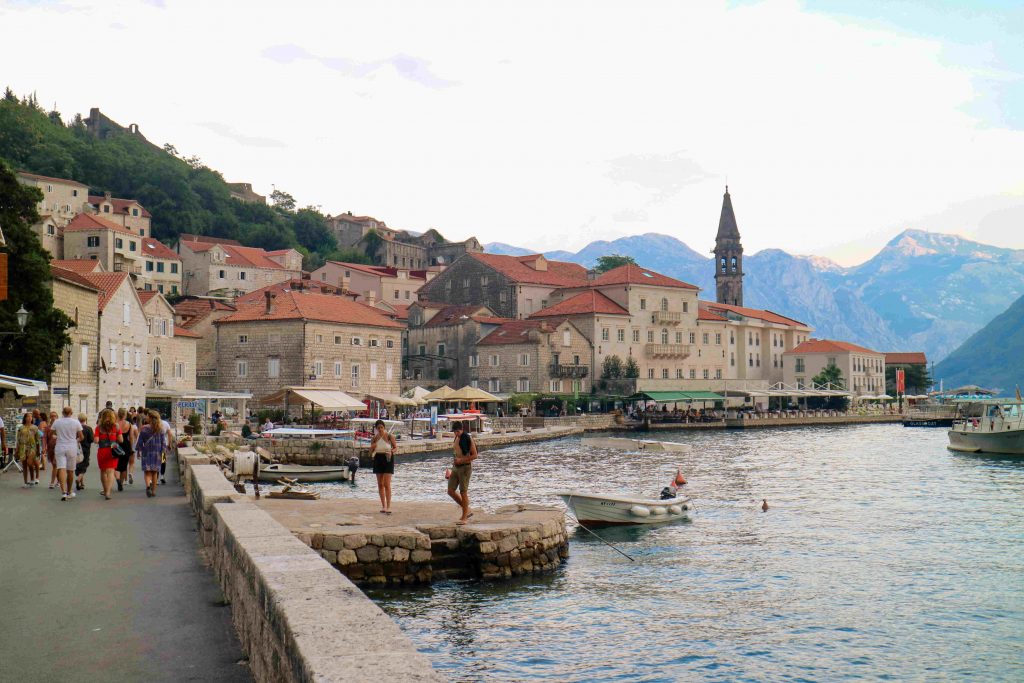
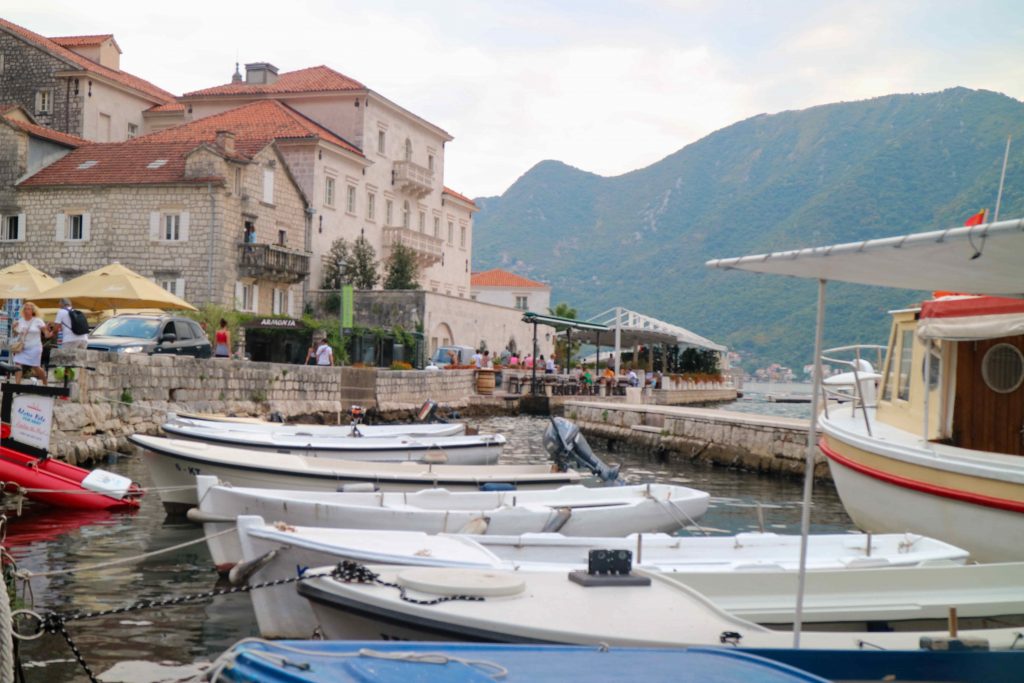
Daytrip to Budva and Cetinje
The days after Kotor, we sunbathed and swam some more, and decided to see some other famous sights. Like Sveti Stefan, the city in the water, but as if the jampacked traffic on the road was not telling enough, it was impossible to park anywhere near this landmark. Having quickly seen it from our car window, we drove onto Budva, which I remember as a very hot day.
Budva, another medieval town, is one of the larger cities in Montenegro, which shows through the white modern apartment blocks surrounding the Old Town. After parking the car in a free parking zone on the outskirts of the city, we walked for forty minutes to visit the castle and look at the history and beaches the city was supposed to be famous for. It was definitely pretty with some great architecture, but our impressions of Kotor and our evening in Perast still lived in our heads rent-free.
After some deliberation on what to do, we decided to head back to Bar to chill out at Hemingway’s beach. Google Maps once again showed heavy traffic between Bar and Budva, so we decided to take the long route home – we saved on parking so now we could spend that money on gas!
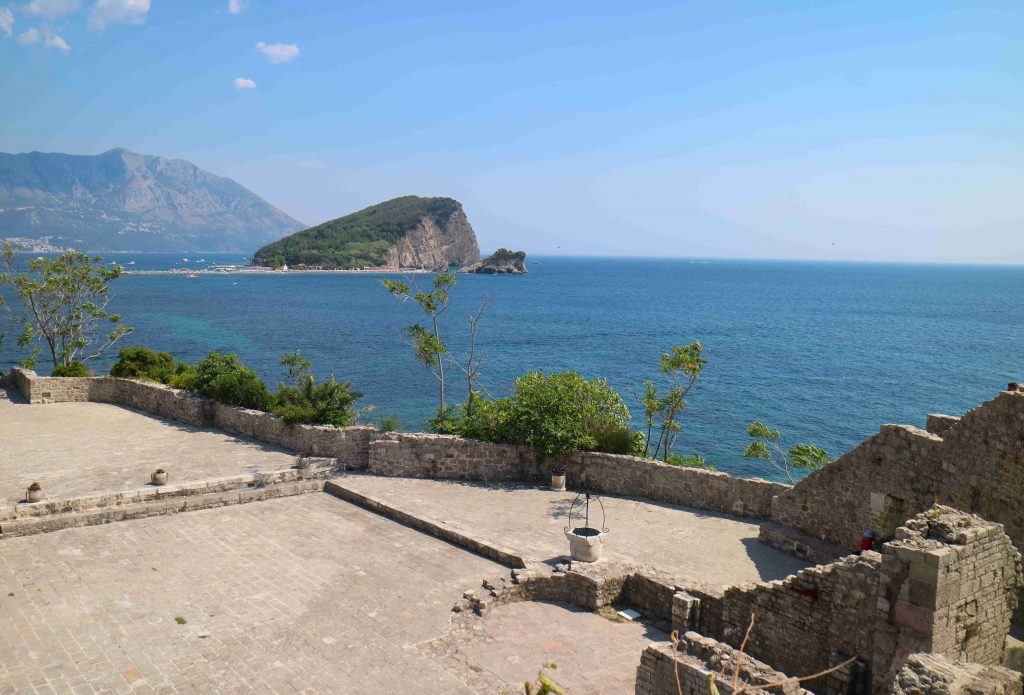
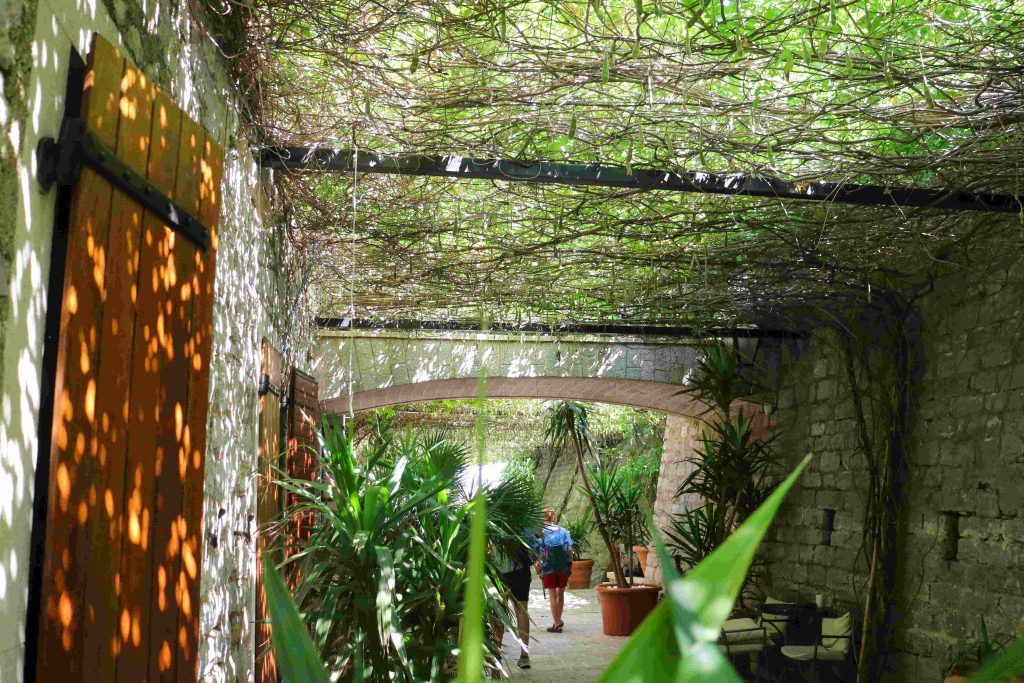
As soon as we lost sight of the ocean the roads became ultra-smooth, cutting through rock formations and higher altitude green pastures. A diverse array of flora and fauna and fresh air welcomed us to Montenegro’s mountains: the smell of fir trees coming closer as we made our way to the country’s previous capital, Cetinje. Wessel and I looked at each other, sad we only had so little time here, but also surprised by the beauty of the country’s wilderness, which we by then were craving to explore. Too soon, however, we reached the city.
Nestled in the forest, the town of Cetinje was a small haven with only a handful of restaurants and old politicians’ villas from back in the day. There, we had some much-needed cevapi, a traditional Balkan dish you can find on any menu, anywhere in the region. Made of minced meat and some hearty spices, it is usually served with pale green salad and thin French fries (if you are ‘lucky,’ they are a little soggy from the cevapi).
After dinner, we walked around a bit more, but as the sun was beginning to set, we drove home, not wanting to navigate the mountains in the dark. The landscape changed every ten minutes: from peaks, to plains, to hilly coastline. The tranquility did not last long, however. While sitting in another traffic jam, we realized this was the third one caused by a road accident. It was then we saw the airbags on our BMW were out of order. Let’s just say I was very happy to get home in one piece. Relieved, we fell asleep quickly, ready to spend one more day lounging on the beach club sunbeds, before heading to the next country on our itinerary: Bosnia Herzegovina.
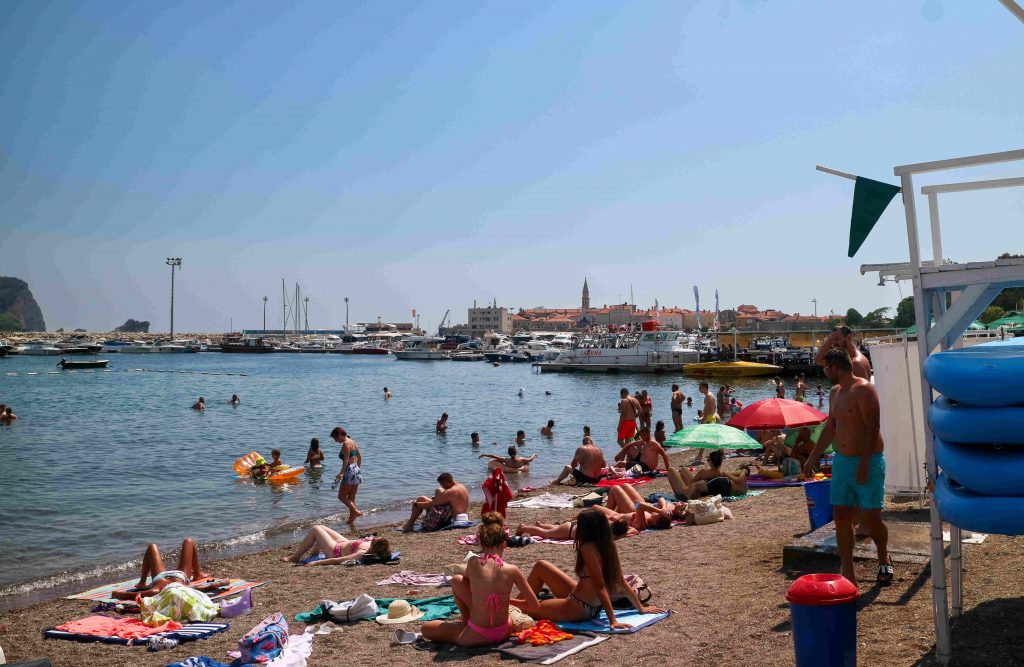
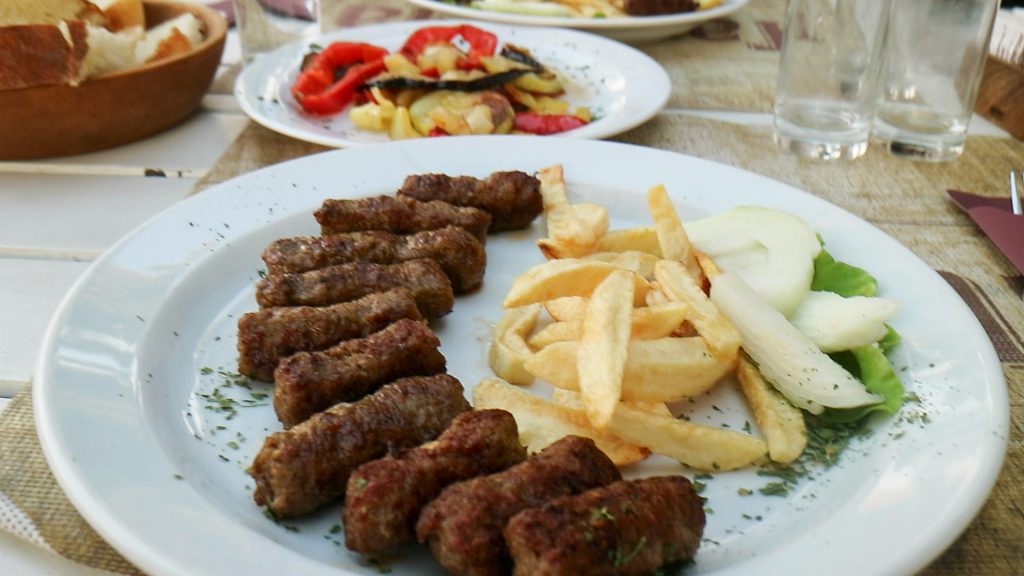
Final Thoughts
If it was not clear yet, Montenegro completely blew us away. From her medieval towns to her diverse flora and dramatic landscapes: this country has got it all. I would advise any traveler thinking of seeing the Balkans to not skip this small country on the Adriatic coast, and spend some time exploring her mountains, history, and food. Especially the coastline of the Kotor Bay and the splendid purple sunset we experienced there will never be forgotten.
In the next story I will take you along to the second to last country on our Interrailing trip, a country which history is both tragic and hopeful. The time we spend there interested my conflict studies brain incredibly, but to know everything about that experience, you will have to wait for the next one. If you want to stay up-to-date with all of my travel blogs in the future, make sure to follow me on Instagram or sign up for my newsletter, and get a gluten-free world map, for free!




